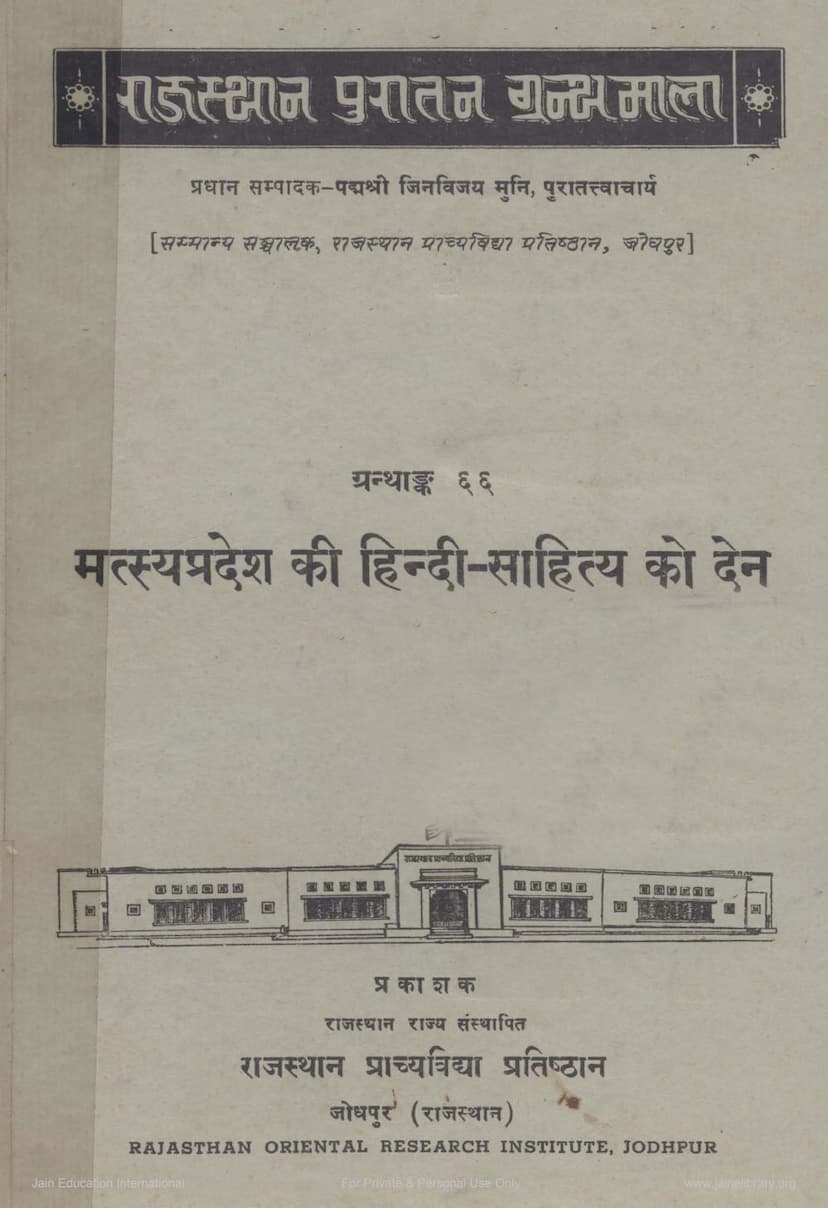Matsyapradesh Ki Hindi Sahitya Ko Den
Added to library: September 2, 2025

Summary
Here's a comprehensive summary of the Jain text "Matsyapradesh ki Hindi Sahitya ko Den" (The Contribution of Matsya Region to Hindi Literature) by Motilal Gupta, published by Rajasthan Prachyavidya Pratishthan, Jodhpur:
Overview:
This book, published as part of the Rajasthan Oriental Research Institute's esteemed "Rajasthan Puratana Granthamala," is a scholarly work by Dr. Motilal Gupta, a Reader in the Hindi Department at the University of Jodhpur. It is dedicated to exploring and cataloging the significant contributions of the historical Matsya region to the development of Hindi literature, primarily focusing on the period between approximately 1750 and 1900 CE. The work is based on extensive research conducted by Dr. Gupta, including direct examination of manuscripts and literary resources within the Matsya region.
Key Aspects and Themes:
-
Historical and Geographical Context of Matsya Pradesh:
- The book begins by defining Matsya Pradesh as comprising the princely states of Alwar, Bharatpur, Dholpur, and Karauli.
- It traces the historical significance of the region, referencing its mention in the Mahabharata and its association with Virat Nagar.
- It notes the geographical proximity of the region to the Braj region, which heavily influenced its linguistic and literary trends.
-
Literary Output of the Region:
- Dr. Gupta meticulously surveys a vast array of literary works, categorizing them into distinct genres:
- Ritikal Kavya (Poetry of the Ritikal): The book details various poetic traditions, schools, and the contribution of Matsya poets to this genre, highlighting prominent figures like Govind Kavi, Shivram, Somnath, Kalanidhi, and others who adhered to classical poetic conventions.
- Shringar Kavya (Poetry of Love and Eroticism): It analyzes the depiction of love, both divine (Radha-Krishna) and human, in the literature of the region, noting the generally restrained and respectful approach even in Shringar themes. It identifies specific works and poets like Devi Das, Somnath, and Bakhatawar Singh's royal poets.
- Bhakt Kavya (Devotional Poetry): A significant portion of the literature is dedicated to devotional poetry, with a strong emphasis on Vaishnavism (Krishna and Rama bhakti). It discusses the influence of Braj devotional traditions, mentions various forms of devotion, and highlights the works of poets like Baldev Kavi, Alibakhsh, Virbhadra, Rasnidhi, Ramanarayan, Somnath, and the Charan Dasis (Dayabai, Sahjobai, Charandas).
- Neeti, Yuddh, Itihas-Sambandhi tatha Anya (Ethics, War, History, and Miscellaneous): This chapter covers didactic literature, heroic poetry and historical accounts, and the influence of the political and social climate on literature. Works like "Pratap Raso" by Jachik Jeevan and "Sujan Charitra" by Sudhan are analyzed for their historical and literary value.
- Gadya-Granth (Prose Works): The book explores the presence and development of prose in the region, including commentaries, historical accounts, and collections of wisdom like "Akalnama." It also notes the use of prose for explanations and in official documents.
- Anuvad-Granth (Translated Works): A significant focus is placed on translations from Sanskrit and Persian into Hindi, demonstrating the region's role in making classical and administrative texts accessible. Notable examples include translations of the Ramayana, Mahabharata, Bhagavad Gita, and Upanishads.
- Dr. Gupta meticulously surveys a vast array of literary works, categorizing them into distinct genres:
-
Key Authors and Works:
- The book highlights numerous poets and scholars who hailed from or were associated with Matsya Pradesh. Prominent among them are Somnath (a prolific poet and scholar), Kalanidhi (known for his translations and poetic skill), Shivram (whose "Navadha Bhakti" received significant royal patronage), Rasanand (recognized for his "Sikhnak" and "Sabhavinod"), Hari Nath (author of "Vinay Prakash"), and Govind Kavi (author of "Govindanandhan").
- It also mentions works by rulers like Maharaja Balwant Singh of Bharatpur, Maharaja Vinay Singh of Alwar, and Maharaja Bakhatawar Singh of Alwar, indicating royal patronage and even participation in literary creation.
-
Literary Characteristics and Influences:
- The dominance of Braj Bhasha as the literary language is a recurring theme, even in areas bordering Rajasthan.
- The impact of the Braj region's culture and traditions on Matsya literature is evident.
- The book discusses the prevalence of Ritikal characteristics, including the focus on Shringar (love and aesthetic sentiment), detailed descriptions of nayika-bheda (heroine classifications), and the use of Vachika-abhinaya (spoken dialogue) in dramatic compositions.
- It notes the influence of Mughal culture on courtly life and, by extension, on certain aspects of the literature, such as court descriptions and artistic depictions.
- A unique characteristic identified is the blend of local dialects and influences, though Braj Bhasha remained the dominant literary medium.
-
Methodology and Research:
- Dr. Gupta emphasizes his direct engagement with the source material, visiting numerous libraries, private collections, and historical sites within Matsya Pradesh.
- He acknowledges the challenges faced due to the scattered nature of manuscripts and the reluctance of some custodians to share their collections.
- The book includes appendices listing poets and works, providing valuable bibliographical information.
Significance and Contribution:
"Matsyapradesh ki Hindi Sahitya ko Den" is a seminal work that illuminates a relatively under-researched area of Hindi literary history. It brings to light numerous unknown or lesser-known poets and their works, enriching our understanding of the regional contributions to the broader Hindi literary landscape. By meticulously cataloging and analyzing this material, Dr. Gupta provides a comprehensive framework for appreciating the cultural and literary richness of Matsya Pradesh, demonstrating its integral role in the evolution of Hindi literature. The book serves as a testament to the preservation efforts of institutions like the Rajasthan Oriental Research Institute and the dedication of scholars in uncovering and disseminating valuable historical and literary treasures.
In essence, the book argues that Matsya Pradesh, despite its historical integration into larger kingdoms and later Rajasthan, possessed a distinct and vibrant literary tradition that significantly contributed to the development of Hindi literature, particularly in the realms of devotional poetry, Ritikal compositions, and historical narratives.